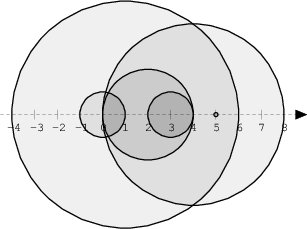🔗 문제 링크
https://app.codility.com/programmers/lessons/6-sorting/number_of_disc_intersections/start/
❔ 문제 설명
We draw N discs on a plane. The discs are numbered from 0 to N − 1. An array A of N non-negative integers, specifying the radiuses of the discs, is given. The J-th disc is drawn with its center at (J, 0) and radius A[J].
We say that the J-th disc and K-th disc intersect if J ≠ K and the J-th and K-th discs have at least one common point (assuming that the discs contain their borders).
The figure below shows discs drawn for N = 6 and A as follows:
A[0] = 1
A[1] = 5
A[2] = 2
A[3] = 1
A[4] = 4
A[5] = 0

There are eleven (unordered) pairs of discs that intersect, namely:
discs 1 and 4 intersect, and both intersect with all the other discs;
disc 2 also intersects with discs 0 and 3.
Write a function:
def solution(A)
that, given an array A describing N discs as explained above, returns the number of (unordered) pairs of intersecting discs. The function should return −1 if the number of intersecting pairs exceeds 10,000,000.
Given array A shown above, the function should return 11, as explained above.
⚠️ 제한사항
-
N is an integer within the range [0..100,000];
-
each element of array A is an integer within the range [0..2,147,483,647].
💡 풀이 (언어 : Python)
풀이 방법이 전체 탐색외에는 떠오르지 않아 타인의 풀이를 참고했다. 풀이는 꽤 기발한 아이디어다. 한 flow로 교집합의 수를 모두 체킹하는 알고리즘이다. 왼쪽 끝과 오른쪽 끝 좌표를 나누고 이것들을 합친 후에 정렬해서 가장 왼쪽 좌표부터 카운트를 시작해 원의 열고 닫힘을 보면서 겹치는 원의 수를 카운트해주는 아이디어이다.
def solution(A):
lis = []
for i, a in enumerate(A):
# -1은 왼쪽 원의 끝, +1은 오른쪽 원의 끝
lis.append((i-a, -1))
lis.append((i+a, 1))
# 가장 왼쪽 기준(음수)에서 시작
lis.sort()
# 교집합 수
intersect = 0
# 아직 열려있는 원(카운트 중인)의 수
opened = 0
for i in range(len(lis)):
# 원의 오른쪽 끝 좌표만나면 열린 원의 개수 차감
if lis[i][1] == 1:
opened -= 1
# 열린 원의 수만 큼 중첩해서 교집합 수 카운트
# 원의 왼쪽 끝 좌표만나면 열린 원의 개수 증가
if lis[i][1] == -1:
intersect += opened
opened += 1
# 천만개 초과시에 -1 반환처리
if intersect > 10000000:
return -1
return intersect
